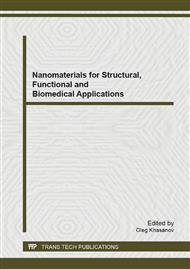p.65
p.70
p.74
p.79
p.84
p.89
p.94
p.106
p.112
Structural State, Phase Composition and Mechanical Properties of Wear-Resistant Cast Iron Modified by Ultrafine Powders
Abstract:
The paper explores the effect of a modifier based on ultrafine powders of refractory metal oxides on the change of structural state, phase composition and mechanical properties of cast iron of ИЧХ28Н2 (Russian grade). It was shown that the modifier added to the melt does not change the phase composition of ferrite-austenitic matrix and carbides and is not carbide-forming. Material microstructure changes only due to the presence of a large amount of crystallization nuclei during the casting cooling. It was established that the modification increases the ultimate stress limit by 53%, plasticity by 10.7%, corrosion resistance by 15%, and leads to the reduction of friction factor and linear wear due to the decreasing of structural elements: carbide phase and austenitic-carbidic eutectic.
Info:
Periodical:
Pages:
84-88
Citation:
Online since:
December 2013
Price:
Сopyright:
© 2014 Trans Tech Publications Ltd. All Rights Reserved
Share:
Citation:


